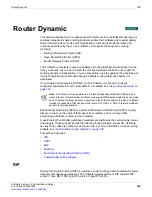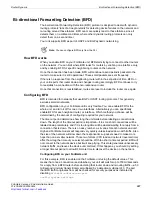
Router Dynamic
OSPF
FortiGate Version 4.0 Administration Guide
01-400-89802-20090424
295
•
OSPF-enabled routers generate Link-State Advertisements (LSA) and send them to their
neighbors whenever the status of a neighbor changes or a new neighbor comes online. As
long as the OSPF network is stable, LSAs between OSPF neighbors do not occur. An LSA
identifies the interfaces of all OSPF-enabled routers in an area, and provides information
that enables OSPF-enabled routers to select the shortest path to a destination. All LSA
exchanges between OSPF-enabled routers are authenticated.
The FortiGate unit maintains a database of link-state information based on the
advertisements that it receives from OSPF-enabled routers. To calculate the best route
(shortest path) to a destination, the FortiGate unit applies the Shortest Path First (SPF)
algorithm to the accumulated link-state information. OSPF uses relative path cost metric
for choosing the best route. The path cost can be any metric, but is typically the speed of
the path—how fast traffic will get from one point to another. The path cost, similar to
“distance” for RIP, imposes a penalty on the outgoing direction of a FortiGate interface.
The path cost of a route is calculated by adding together all of the costs associated with
the outgoing interfaces along the path to a destination. The lowest overall path cost
indicates the best route, and generally the fastest route.
The FortiGate unit dynamically updates its routing table based on the results of the SPF
calculation to ensure that an OSPF packet will be routed using the shortest path to its
destination. Depending on the network topology, the entries in the FortiGate routing table
may include:
•
the addresses of networks in the local OSPF area (to which packets are sent directly)
•
routes to OSPF area border routers (to which packets destined for another area are
sent)
•
if the network contains OSPF areas and non-OSPF domains, routes to AS boundary
routers, which reside on the OSPF network backbone and are configured to forward
packets to destinations outside the OSPF AS.
The number of routes that a FortiGate unit can learn through OSPF depends on the
network topology. A single unit can support tens of thousands of routes if the OSPF
network is configured properly.
Defining an OSPF AS—Overview
Defining an OSPF Autonomous System (AS), involves:
•
defining the characteristics of one or more OSPF areas
•
creating associations between the OSPF areas that you defined and the local networks
to include in the OSPF AS
•
if required, adjusting the settings of OSPF-enabled interfaces.
If you are using the web-based manager to perform these tasks, follow the procedures
summarized below.
To define an OSPF AS
1
Go to
Router > Dynamic > OSPF
.
2
Under Areas, select Create New.
3
Define the characteristics of one or more OSPF areas. See
.
4
Under Networks, select Create New.
Note:
The inter-area routes may not be calculated when a Cisco type ABR has no fully
adjacent neighbor in the backbone area. In this situation, the router considers summary-
LSAs from all Actively summary-LSAs from all Actively Attached areas (RFC 3509).
Summary of Contents for Gate 60D
Page 705: ...www fortinet com...
Page 706: ...www fortinet com...


































